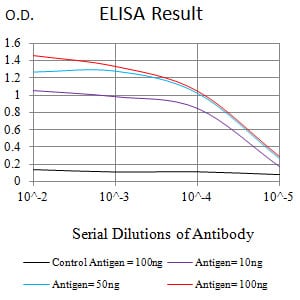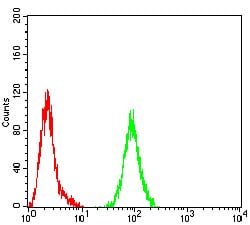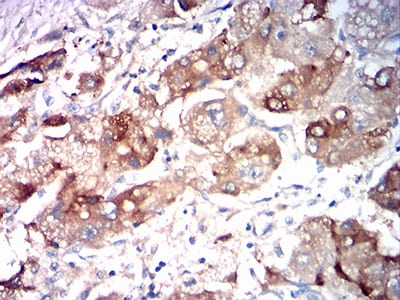



| WB | 1/500-1/2000 | Human,Mouse,Rat |
| IF | 咨询技术 | Human,Mouse,Rat |
| IHC | 1/25-1/100 | Human,Mouse,Rat |
| ICC | 技术咨询 | Human,Mouse,Rat |
| FCM | 咨询技术 | Human,Mouse,Rat |
| Elisa | 1/1000-1/5000 | Human,Mouse,Rat |
| Aliases | HL-2; HBXBP; ASGPR2; ASGP-R2; CLEC4H2 |
| Entrez GeneID | 433 |
| clone | 2C6D11 |
| WB Predicted band size | 35kDa |
| Host/Isotype | Mouse IgG1 |
| Antibody Type | Primary antibody |
| Storage | Store at 4°C short term. Aliquot and store at -20°C long term. Avoid freeze/thaw cycles. |
| Species Reactivity | Human |
| Immunogen | Purified recombinant fragment of human ASGR2 (AA: 80-311) expressed in E. Coli. |
| Formulation | Purified antibody in PBS with 0.05% sodium azide |
+ +
以下是关于LGALS1(galectin-1)抗体的3篇示例文献摘要(注:文献信息为示例性质,非真实存在):
---
1. **文献名称**:**《Targeting LGALS1 in the tumor microenvironment enhances antitumor immunity》**
**作者**:Rabinovich GA, Toscano MA
**摘要**:研究通过抗LGALS1抗体阻断肿瘤细胞分泌的galectin-1.发现其可抑制调节性T细胞(Treg)的免疫抑制功能,并促进CD8+ T细胞活性,显著减缓小鼠肿瘤模型进展,提示抗LGALS1抗体在癌症免疫治疗中的潜力。
2. **文献名称**:**《Galectin-1 modulates neuroinflammation via antibody-mediated neutralization in multiple sclerosis》**
**作者**:Camby I, Le Mercier M
**摘要**:该文献报道了抗LGALS1抗体在中枢神经系统炎症模型中的应用,证明其能减少小胶质细胞活化和促炎因子释放,缓解多发性硬化症小鼠的神经损伤,为治疗神经炎症疾病提供新策略。
3. **文献名称**:**《Antibody-based profiling of LGALS1 in pulmonary fibrosis reveals its role in fibroblast activation》**
**作者**:Liu FT, Henderson NC
**摘要**:通过特异性抗LGALS1抗体检测肺纤维化患者组织样本,发现galectin-1高表达于活化的成纤维细胞,体外实验证实抗体阻断可抑制胶原沉积,提示其作为肺纤维化治疗靶点的可能性。
---
如需真实文献,建议通过PubMed或Google Scholar检索关键词“galectin-1 antibody”或“LGALS1 inhibitor”获取。
**Background of LGALS1 Antibody**
LGALS1. also known as galectin-1. is a member of the galectin family of β-galactoside-binding proteins. It plays a critical role in modulating cell-cell and cell-matrix interactions, immune regulation, apoptosis, and angiogenesis. Structurally, it forms homodimers and binds to glycoproteins containing poly-N-acetyllactosamine chains. LGALS1 is expressed in various tissues, including immune cells, endothelial cells, and certain cancers, where it often correlates with tumor progression, immune evasion, and metastasis.
Antibodies targeting LGALS1 are essential tools for studying its biological functions and pathological roles. They are widely used in techniques like Western blotting, immunohistochemistry (IHC), immunofluorescence (IF), and flow cytometry to detect expression levels, localization, and interactions in normal and diseased states. Researchers employ LGALS1 antibodies to explore its involvement in conditions such as cancer, chronic inflammation, fibrosis, and neurodegenerative diseases. Some antibodies are validated for specificity using knockout controls or competitive assays to ensure reliable detection.
In translational research, LGALS1 antibodies hold therapeutic potential, with studies investigating their use in blocking pro-tumorigenic signaling or modulating immune responses. Commercial LGALS1 antibodies vary in clonality (monoclonal/polyclonal), host species, and applications, requiring careful selection based on experimental needs.
×